When was the last time you held hands with a brand?
Customer Bonding 🔗
Compelling, relatable, and memorable stories are more than a strategic device or a marketing tactic — they’re about forming lasting bonds between people. We connect through shared experiences, and our stories reveal our uniqueness, values, and vulnerability. The best stories are ones you can visualize in the retelling; you feel as if you’re there, experiencing the events firsthand. You may not remember what you ate for dinner last night, but you’ll never forget the first book you read and loved. Storytellers can create worlds and characters that draw us in. We immerse, we get involved, and we develop a relationship with the characters and story as it unfolds.
Brands are no different in the power they have to create a conduit for their vision, mission, positioning, purpose, values, and beliefs. You can be a misanthrope firing shots in the dark or a little ray of light. You can be that carefully crafted persona who scores AdWeek accolades, applauding your clever clapbacks in corner offices. You can fly under the radar or be another bot on the assembly line. Pick your poison.
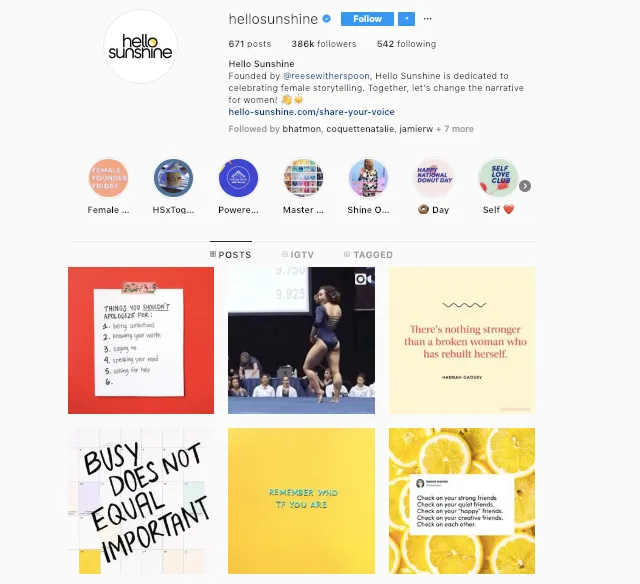
Prospects cleave to what’s familiar and recognizable, and they want to feel their bond is rooted in an emotional connection, shared values, and a mutual understanding — that their link surpasses a transaction. According to a research institute’s two-year study of 100,000 retail customers, “emotionally connected customers have a 306 percent higher lifetime value (LTV), stay with a brand for an average of 5.1 years vs. 3.4 years, and will recommend brands at a much higher rate (71 percent vs. 45 percent).” A Harvard Business Review study concluded that emotional engagement matters more than customer satisfaction and drives brand loyalty (PDF).
How do you bond with your customers? You figure out what they want in exchange for their attention, action, and advocacy.
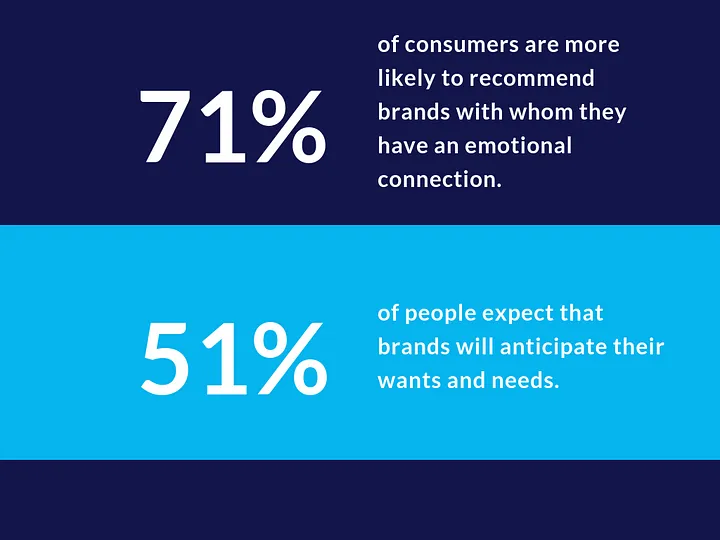
Like any relationship, people want to be heard. They want to know someone is listening and communicating in a way that’s relevant, empathetic, and human. No one wants a robotic, copy-and-paste relationship. If someone is forking over their hard-earned dollars, they want to know they’ve made the right choice. Customers want their brand interactions to be relevant, personalized, varied, and in constant anticipation of their wants and needs: 51 percent of people expect brands to create products and experiences they want before they even know they want them.
The first step in the brand development process is research. You become a CIA operative and use all your sleuthing techniques to learn about your customer beyond basic demographic info and their willingness to spend. You have to know them as people who have real and complicated problems, motivations, behaviors, and habits. Once you know everything there is to know, you become the person who gets them. You realize the power of mirror neurons and how becoming a reflection of your customer is the quickest route to establishing trust.
Your brand is how your customers perceive and value your business. They don’t value a logo and a stock price; they attach themselves to something relevant and meaningful, a brand with depth and dimension. While customers care about what your business offers, how and why it’s different from the other options, and the benefits they’ll gain, they need more. Consumers need an embodiment of who your business is, what it stands for — and this is where brand personality makes its red carpet entrance.
Brand personality 🔗
Brand personality refers to the human characteristics, emotions, and attributes embodied by a brand. It’s a brand made human by the Dr. Frankenstein of marketing departments — although far less nefarious. Your brand’s personality is how it shows up and acts in front of customers. Your brand personality is composed of tone and voice and all the elements that make an individual unique and establish identity.
By intimately understanding your customer, you’re able to shape your brand personality in a way that evokes the “like, know, and trust” factor. Think of it like meeting people at a party:
- There are some you immediately vibe with because something in them evokes feelings of comfort, familiarity, awe, or respect. It may be their look, the way they talk, how they think, what they say, or how they make you feel. This is like a brand attracting the ideal customer — the customer digs the brand and what they have to offer.
- There are other people you’ll like and value in time — the relationship just requires more work. This is a brand attracting the periphery. This might be a customer ambivalent about your brand but who appreciates and values your products. In my early twenties, I had no interest in Eileen Fisher as a brand, but when I found a quality Eileen Fisher cashmere sweater on sale, I still decided to buy it.
- Finally, there are those we dislike on first sight. This is a brand repelling customers it doesn’t want to attract.
There are many ways you can create your brand’s personality, but there are two methods I normally use: Jennifer Aaker’s Five Dimensions of Brand Personality and Carl Jung’s 12 archetypes.
Five dimensions of brand personality 🔗
Behavioral psychologist and Stanford professor Jennifer Aaker designed a framework that posits there are five dimensions to one’s personality, and each contains a set of facets. Each facet contains a set of traits.
To apply these to a brand, you rank the traits on a scale of one to five, with one being the least representative of your brand and five being the most. The Five Dimensions Framework can be used to compose the personality of a new brand or to articulate a brand’s current state (defined by customer perception and attitudes) and future state (defined by desired perception).
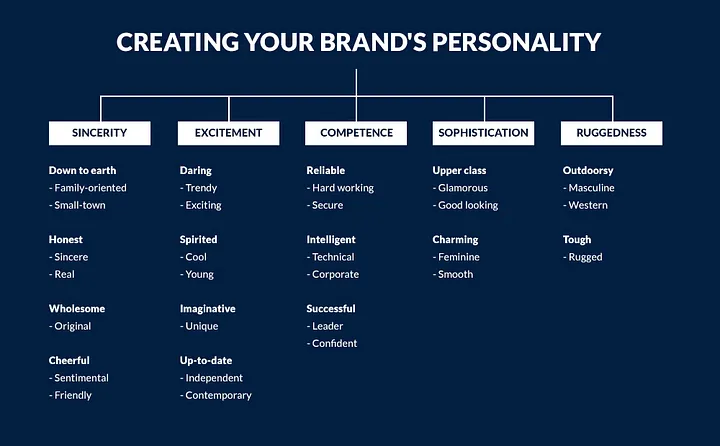
Carl Jung’s 12 archetypes 🔗
If you’re a fan of old school psychology, Carl Jung might be your man. Jung was downright surgical in his exploration and dissection of the human psyche. Jung developed 12 archetypes that were emblematic of recurring behavioral patterns and motivation. His theory was that the identities are derived from our most primitive instincts and collective unconscious, forming the foundation of who we are and what stories we tell and surface in our culture. We tend to have one dominant personality, but often we’ll have a back-up dancer as well.
Four essential goals form the center of the framework:
- Yearn for paradise, driven by our quest for freedom
Make our mark, driven by our ego
Connect with others, driven by social desire, comfort, and emotional connection
Provide structure to the world, driven by a need for rules and order

Within that framework are the 12 main archetypes.
- Innocent: The Innocent is the one sharing optimistic quotes on Instagram. They’re romantics, dreamers, and they ache for the traditional and nostalgic. Brand example: Little Debbie exemplifies nostalgia to the core with their name and iconic 1950s packaging.
- Sage: The Sage hunts for the truth and believes in self-reflection. Hungry for knowledge in all its forms, they’re detectives, scholars, academics, philosophers, thinkers, and data junkies. Brand examples: Harvard, Stanford, and Cambridge Universities (and research facilities) epitomize the perennial student and information-seekers.
- Explorer: The Explorer eschews boundaries and limits. Don’t ever box them in. They’re nonconformists, iconoclasts, nomads, and pilgrims. Brand example: Harley Davidson attracts older men with sleeve tattoos as well as millennial weekend warriors. At the core of their brand promise is freedom — their customers can go wherever they want, whenever they want.
- Outlaw: The Outlaw wants to fight the system. They’re rule-breakers and misfits who want to disrupt, shock, and destroy the status quo. Brand example: When Apple launched iTunes, iPods, and iPhones, they revolutionized how people purchase, collect, and listen to music; they transformed the phone into a pocket computer.
- Magician: The Magician is about making magic happen. They’re charismatic visionaries who make their wildest dreams a reality. The magician is an inventor, healer, doctor, creator, and transformer. Brand example: Disney embodies a world where we frolic alongside princesses and cute mice.
- Hero: The Hero’s uniform is a cape, and they’re always up for a challenge. They’re fearless, strong, competent, and agile. They’re on the front lines as warriors, superheroes, and soldiers. Brand examples: Marvel and the U.S. Army represent our imaginary and real heroes.
- Lover: The Lover is all about intimacy, relationships, passion, and compassion. They’re partners, friends, team-builders, support staff, and sensualists. Brand examples: Agent Provocateur, Victoria’s Secret, and Hershey’s Kisses all quicken and warm hearts.
- Jester: The Jester is the joker, the kind of person living their best life right now. Their goal is to get you to giggle by any means necessary. They’re comedians and pranksters. Brand example: Wendy’s annual Twitter roast made people laugh, cry, or a combination of both.
- Every Person: The Every Person is the one you want to grab a beer with. Pretension-free, they have solid values, are free of artificial sweeteners, and serve as a relatable neighbor. Like Patrick Bateman said in American Psycho, they want to “fit in.” Brand example: Dunkin Donuts, whose tagline is “American runs on Dunkin.” It’s coffee for the everyday person on the go.
- Caregiver: The Caregiver is altruistic, generous, kind, and empathetic. They believe in a life of serving others, nurturing others, and as a result, they elicit consumer trust. Brand examples: World Wide Fund for Nature, Greenpeace, and St. Jude Children’s Research Hospital all exude selflessness.
- Ruler: The Ruler wants to crush the competition. They’re powerful leaders who believe in winning as the ultimate goal. They’re role models, leaders, aristocrats, and politicians. Brand example: Tesla was a leader in the luxury car market.
- Creator: The Creator is the artist with a boundless imagination. They’re visionaries who use their skills and talents to represent the world in a new, unique way. They hunger for innovation, creativity, and perfection. While both Creators and Magicians inspire imagination, Creators dig in tactically to create covet-worthy products. Brand examples: Crayola and LEGO are prime examples of Creators.
As you can see, a brand like Disney is demonstrably different from Harley Davidson and St. Jude in all aspects of their brand, from their look, feel, energy, voice, and vibe to the products they sell and how they cultivate relationships with their customers. Your brand personality is a mirror of your audience and it’s the umbrella under which you craft a verbal and visual voice, i.e.., the practical expressions of the personality.
What’s your style? How do you express yourself? How do you behave? What are the words you use, your lexicon? How do you say hello? If you think of your brand, your personality is the house and your tone and voice are your curtains, furniture, wallpaper, and fancy aromatic candles. It’s about the deliberate choices you make in expressing yourself. It’s the difference between how Fenty Beauty and Estée Lauder talk about new product launches.
Brand tone of voice 🔗
Your brand’s core personality, disposition, outlook, and spirit shape its voice, tone, tenor, and temperament. As a result, the tone and voice drive how you communicate in all your brand’s actions and interactions. Your voice, tone, and temperament should be wholly distinctive and consistent in all aspects of your brand. Wouldn’t it be odd to connect with a super familiar, warm voice on Instagram and then visit a site that’s cold and impersonal? Your customer would be confused by that kind of bait and switch, and confusion drives brand abandonment.
Think of the voice you use every day. It exists and is part of your personality and energy. Think of the words you use and how you use them. Think of the images, colors, and fonts you cleave to. Consider the tenor, pitch, and velocity of your voice. Claim your words and -isms. Establish your style. But remember, your brand isn’t limited to adopting the voice of the owner. What might work for a small business could be an epic fail for a multinational corporation. Imagine the CEO of Taco Bell’s voice all over social media? I shudder to think. You could be yourself, a character, or the creation of the voice of your brand: It all depends on the size of your business, the industry you’re in, and what feels right and natural.
The end goal is to create verbal and visual guidelines that will guide all aspects of your brand’s communication.
The tone of voice is the expression and embodiment of your brand’s personality, beliefs, and values — the person behind the brand. Your tone is not only about how you speak, but also the words you use and how you use them (i.e.., the cadence and rhythm, velocity, and length of your speech).
For example, do you speak fast or with a drawl? Are you loud and bombastic or quiet and reserved? Do you speak in long, ornate sentences, or are you punchy and to-the-point? Do you use emojis? Do you use industry jargon or plain English? Are you cashing in on all your 50-cent words, or are you keeping it simple?
How to capture and craft your tone and voice 🔗
First things first: Get in a room with a whiteboard, lots of paper, pens, markers, and food. Yes, you’ll need food. And water.
Revisit your customer profile. Make sure you know everything about your prospect, including demographic and psychographic information as well as any linguistics intel (i.e.., how they speak about your company and competition). I would have that front and center. If you’re using a whiteboard, sketch out their profile and pull a Brian De Palma where you have customers on one side and you on the other.
Revisit your brand personality profile. Your brand’s voice must align with its personality. Customers crave clarity and consistency, so switching things up and acting like you’re James McAvoy in Split is not a good look. Let’s say you sell cowboy boots. Your vibe is laid-back and rugged. So you wouldn’t put on airs on social media and prance around wearing Chanel ballet flats.
Create a mood board. Normally, I’d run screaming at the mention of a mood board, but in this case, it’s helpful to visualize key elements of your brand’s personality as well as diagram what your brand would look like if it were a real person. You don’t have to pull images related to your products — in fact, don’t do that because you’ll end up locking yourself in a Schrödinger’s cat tactical box.
Pull images, quotes, colors, photographs, people, and things that inspire you and connect directly with your brand personality. You’ll notice that certain themes will emerge. What kinds of photography attract you? Are the people in photographs you’ve sourced your ideal customer? If not, who do they represent? In clipped quotes or phrases, are there similarities between the words used and how they’re written? Create a second mood board that documents the outcomes and results from the perspective of your prospect. What are they saying? What are they seeing and hearing? How do they look and feel? Imagine your brand, as influenced by your customer, and how your customer perceives your brand and products as a result. Visualize this interconnected relationship and journey.


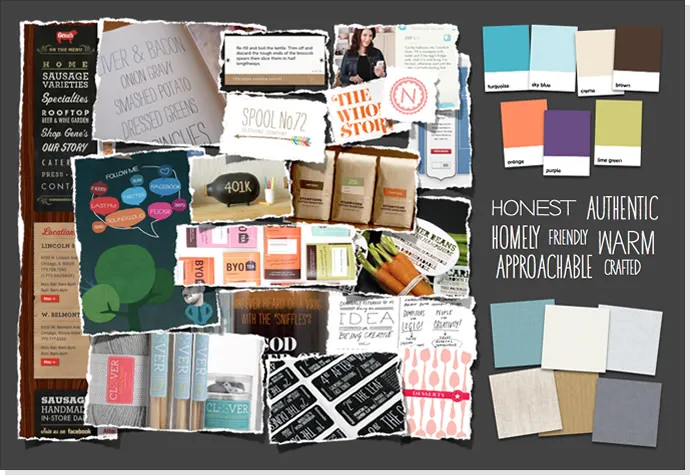
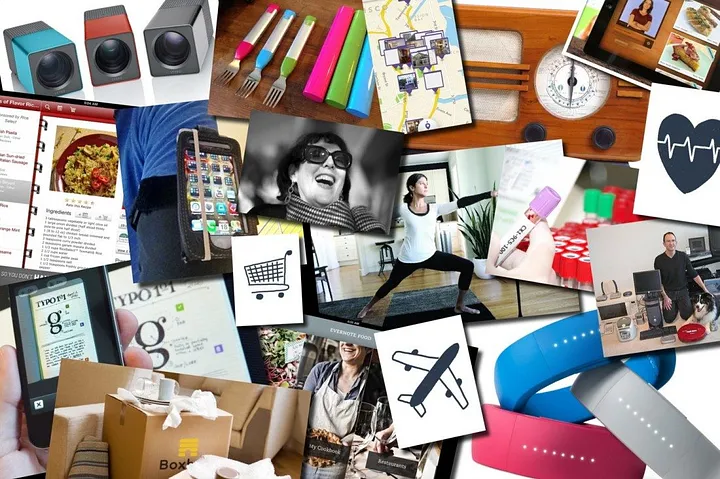
Bring your personality to life. Ask yourself, how would my brand’s personality come through in various mediums, like email, blog posts, social media, the “about” page on the website, product landing and detail pages, and elevator and signature stories? How is your office styled and decorated? Draft sample posts and copy and read them aloud. Do they feel natural? Do they evoke the personality you want to convey? Try to encapsulate your brand style in a single sentence: “My approach is a mix of ___________ meets ___________.”
Window shop. Identify brands that fuel you and target your ideal customer. The “inspo” brands don’t need to be in your industry; they just need to give you the warm fuzzies. They make you stop and stare. Brands often forget that prospects are multifaceted; they buy a whole range of products unrelated to what you offer. When you window shop, look for verbal and visual voice inspirations, i.e.., what the messages, voice, color, design, look and feel convey.
Channel real people. This exercise starts the contextualization process. It’s like window shopping using real people. If your brand were a person would it be Selena Gomez, Reese Witherspoon, or Shonda Rhimes? Or would it be a combination of people? Identify the people you seek to channel and define the attributes that align with your brand.
Perform an on-brand and off-brand exercise: It’s important, especially when you put your brand out there, that you’ve established guardrails for your tone and voice. Document words, images, styles, ways of speech, etc., that do and don’t exemplify your brand. Talk about your brand do’s and don’ts. Document subjects, topics, and language you want to avoid. What’s your take on swearing or emojis? When it comes to grammar, are you into AP or Chicago Manual of Style?
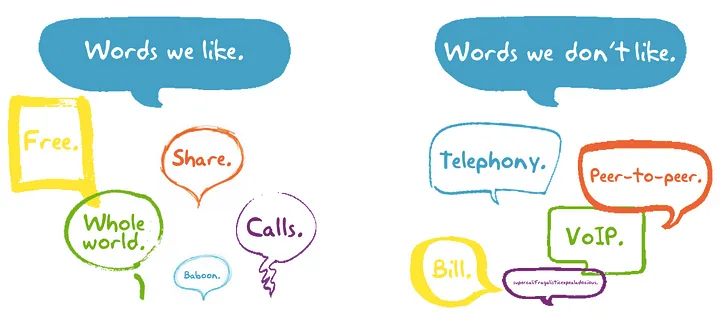
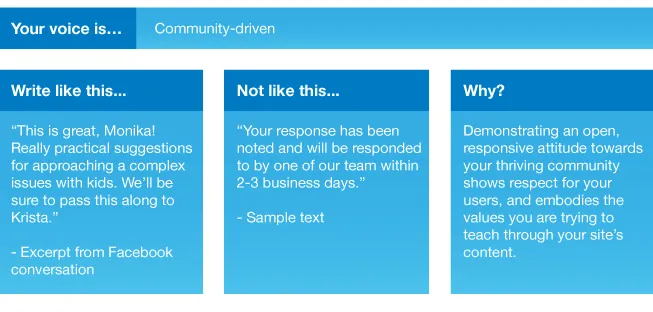
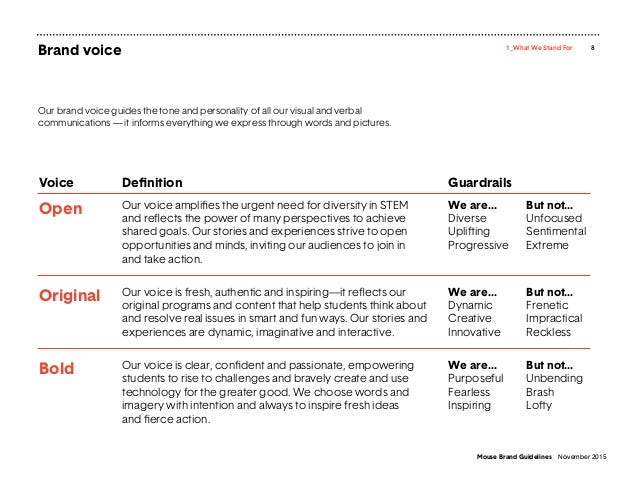
Brand voice and tone examples: Mailchimp, Skype, Berghaus, and Bank of America all have voice and tone guidelines.
Tips for Brand Voice and Tone 🔗
- Don’t be a copycat version of someone else. Just because a voice works for one brand doesn’t mean it’ll work for you. Cultivating a voice isn’t a plug and play. Parroting invites parody.
- Being authentic is about acting natural, relatable, and human. If your brand’s voice feels awkward and forced, it isn’t your voice.
- Lean on your story. We talked about how to craft stories for your brand that are impassioned and compelling. If you get stuck, talk about what’s familiar and meaningful to you. Use details, examples, and anecdotes. You’ll find that your voice will rise seamlessly to the surface.
- Step outside your industry and search for voices and vibes you admire. When you hover too close to home, you inadvertently pick up phrases, turns of speech, and other brand -isms. Seeking inspiration beyond your competition will give you a fresh perspective.
- Point of view matters. If your voice is in the first person, it’s the most intimate. Typically, this works best for small businesses and creative entrepreneurs. Many companies love the royal “we” because it feels warm and inviting without being intrusive.
- Don’t be all things to all people. Brands are scared. They don’t want to lose a sale or alienate a customer, so they pander to everyone. In an effort to appeal to the masses, their message and uniqueness can become dulled and diluted. The most influential brands alienate people because they know this one simple truth:
For example, if you sell $100,000 cars, own it. Don’t create value and budget messaging. Your brand targets a specific audience and you have to cater to that audience. Don’t worry — if your products are solid, you will also attract the periphery.
Once you’ve got these brand fundamentals in place, pull everything together into a brand personality, voice, and tone guideline document. CoSchedule has an excellent and detailed PowerPoint template for this.
The next step is to bring in a creative director/graphic designer to create your visual identity guidelines (or brand system). Your visual identity will include logo and logo usage, fonts, typography, photography and illustration guidelines, design elements (i.e.., print and online collateral examples and rules of the road). Examples of visual identity guidelines: Netflix, Toyota, Skype, University of Houston, and IKEA.
Now that we’ve got your brand personality, voice, and tone on lock, let’s move on to SWOT analysis.
Additional resources 🔗
- Wharton’s “Emotional Rescue: How Brands Can Create Stronger Customer Bonds”
- CoSchedule’s excellent article on creating brand voice guidelines and this comprehensive how-to guide
- How to create a brand design guide
- For kicks, take Psychologist World’s Jung archetype quiz
- Canva’s “50 Meticulous Style Guide Examples Every Startup Should See Before Launching”
- This video tutorial and transcription was created for copywriters: Copyhacker’s “How to Edit for Voice and Tone”
- CoSchedule’s “How to Establish a Unique [Brand Voice](https://coschedule.com/marketing-strategy/brand-voice/”
- Harvard Business Review’s “What Does Your Brand Sound Like?”
- LinkedIn’s free course on developing your brand voice and their excellent brand-building workshop


